This Sunday brings the conclusion to this year’s instalment of the UEFA Champions League. The single match knockout style of this tournament has offered a much different dynamic than it normally presents.
Bayern Munich come into this final on the back of dominating their opponents through their incredible positional play and high pressing, who will look to dominate from the off through possession. PSG offer a much different approach, looking to use their speed and flair players to the best of their abilities. They are regularly at their best with space to run into on the break. These differences will provide a very intriguing final on Sunday.
This tactical analysis preview will look at both sides and identify areas this match could be won and lost in. While Bayern enter as favourites, PSG’s style represents a very dangerous opposition to the Bundesliga champions. This analysis will be broken down into six sections going over these different tactics between the two sides.
PSG’s defensive structure
Moving into this match, both sides will look to play to their strengths. Bayern Munich will undoubtedly aim to establish their dominance from the off, using their positional play while aiming to hold possession in PSG’s half. This is how the German side approaches all of their matches, and therefore are likely to continue in this vein given their success.
Off the back of this, Bayern’s high possession style could work to PSG’s advantage. However, before they can look to exploit Bayern’s weaknesses, they must first ensure they are defensively sound.
A 4-4-2 defensive system would likely give the Ligue 1 champions the best chance in finding success with this. There are many advantages to this structure we can look at as to why it should be implemented, and this moves into the transition phase between defending and attacking.
Tuchel often works his formations around getting the best out of his players. As we have seen in previous matches and will discuss further, systems used such as the 4-2-2-2 in possession are designed for this exact purpose. So how will the 4-4-2 allow PSG to get the best out of their players?
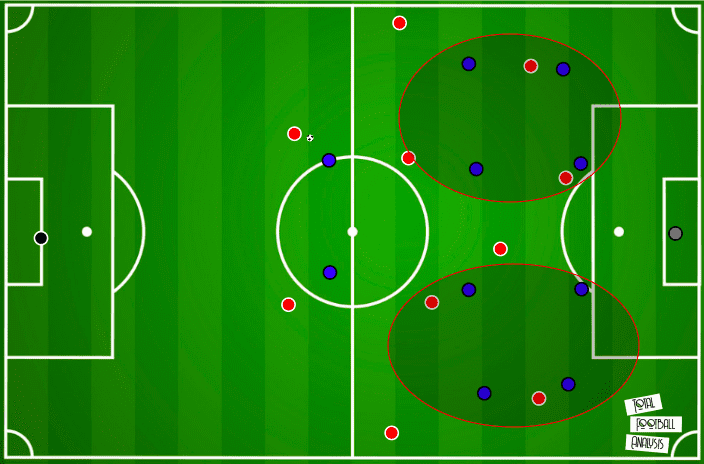
The biggest defensive advantage with the 4-4-2 is the cover in wide areas for the full-backs. Bayern are notorious for using the wide and half-spaces to move through their attacking progressions. The 4-4-2 will give PSG four defensive players who can help in these deeper positions along with a striker who can drop in and provide aid when needed. Marquinhos and Leandro Parades have both been excellent in the absence of Marco Verratti in the centre of the pitch and would be the ideal pairing in this system. Out wide, Ángel Di María has shown a tremendous work ethic and would be relied upon to keep Joshua Kimmich marked on the left side. As for the right side, Ander Herrera could be deployed in this position. During his time at Manchester United he successfully man-marked Eden Hazard out of games using his defensive capabilities.
When possession is regained, this system can easily transition. Herrera inverts into a central midfield role while Di María joins the forward line with Neymar and Kylian Mbappé to return to PSG’s natural 4-3-3.
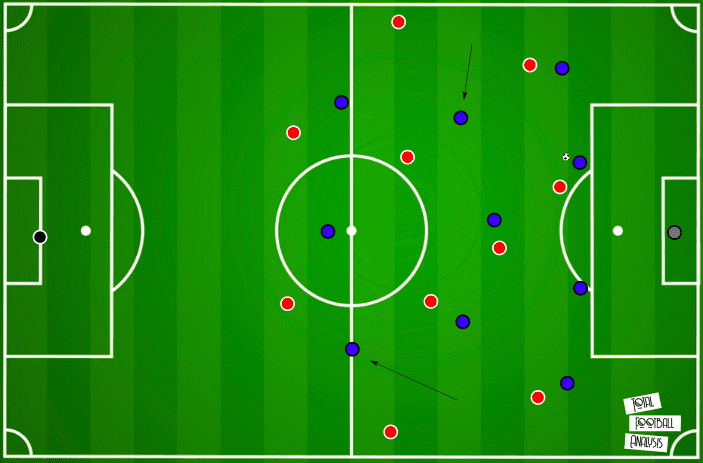
Exposing Bayern’s high line
Much was made after Bayern’s match against Lyon regarding the positioning of the German side’s defensive line. In the first 15 to 20 minutes of the match, Lyon were a constant threat by leaving Memphis Depay and Karl Toko Ekambi holding positions close to the Bayern centre backs. Depay, in particular, consistently occupied the central space to exploit as the centre backs split moving into the half-spaces to progress Bayern’s attack.
On Sunday, PSG have the opportunity to look to use similar tactics that we saw in this semi-final from Lyon. It is very unlikely we will see Bayern Munich alter their approach much if at all, with their high intensity and high pressing scheme having got them to this point with an abundance of success. This poses the question: how can PSG work to exploit this in ways that Lyon were ultimately unsuccessful in doing.
The primary channel of attack we will focus on is through the centre. In this area we have seen opportunities to expose Bayern’s transition process between their possession-based structures.
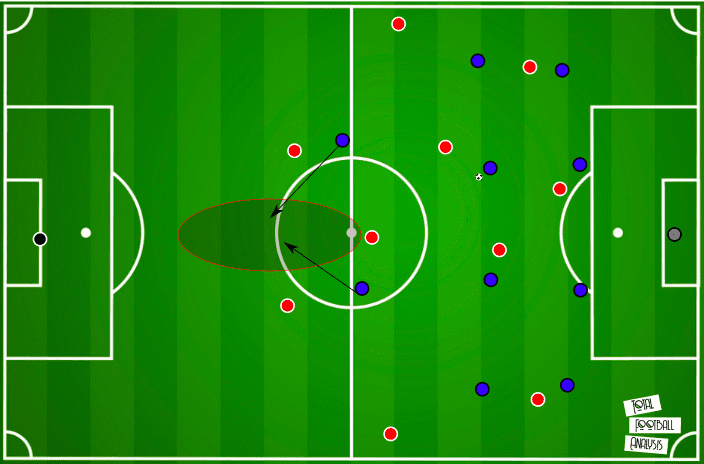
As mentioned above, PSG would be best suited to utilise a 4-4-2 defensive scheme. In this, they would leave two players, Neymar and Mbappé, in an advanced position to look to find opportunities to catch Bayern on the break. Due to the German’s attacking system focused on moving possession through the half-space, the centre backs drift into these wider areas to begin this build-up. The potential downside to this is the isolated situation these defensive players can be left in. In order for this space to open up, Bayern spread wide, with the near-side full-back moving high on the touchline, while the deep midfielder will move away into more of a central position in order to drag out the opponent’s defensive block and open up space for a pass into the winger in the half-space. You can see in the image above how this could look with PSG’s system. Neymar could play a slightly deeper role to look to receive passes upon the French side gaining possession, with Mbappé playing directly off of the back shoulder of Alaba or Boateng to make runs in behind.
This tactic leaves space through the centre of the pitch, where Lyon looked to exploit and PSG can aim to as well. In the image below we can see Bayern holding possession just inside Lyon’s half. Thiago has stepped out of his position in front of the defence to try and break the Lyon defensive block but makes a bad pass in attempting to do so.
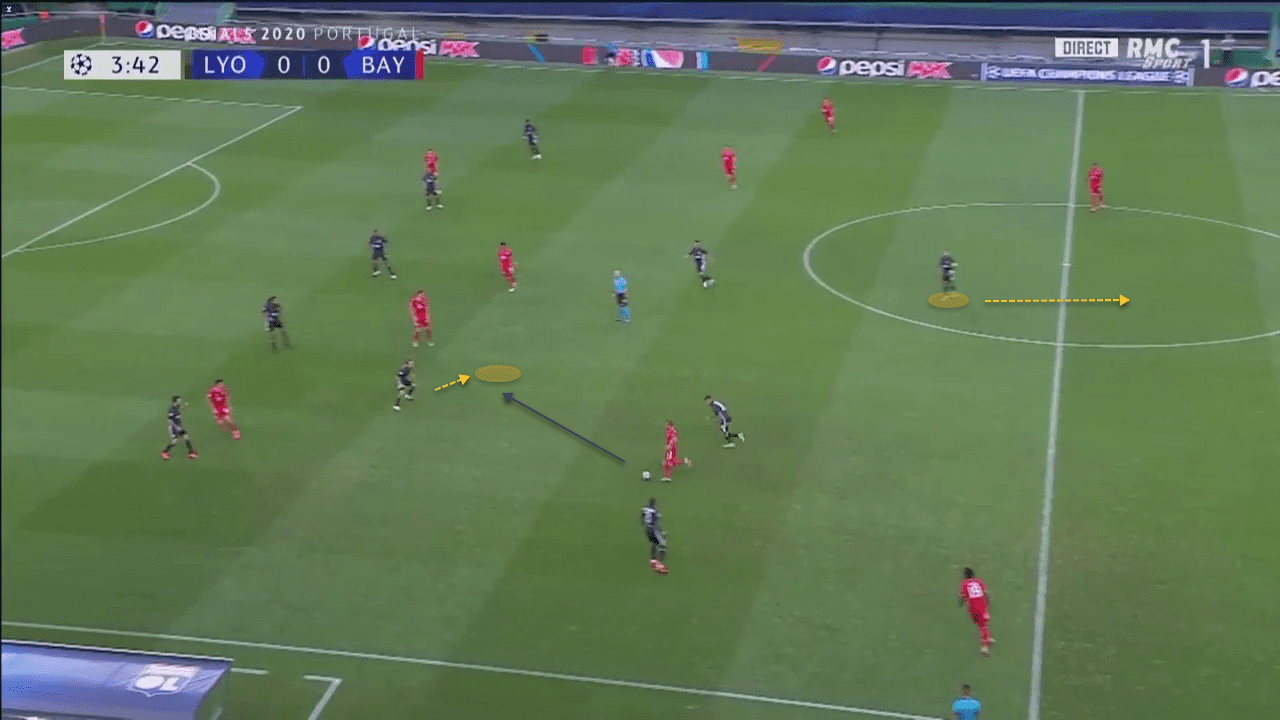
As soon as they win back possession, Depay drives straight into this space between Bayern’s central-halves, as they are spread out to provide a link to either side of the pitch through each half-space. The pass is played and the Dutch international is through on goal but is unable to finish the opportunity. The likes of Mbappé, however, would be favoured to come out on top in this situation on Sunday.
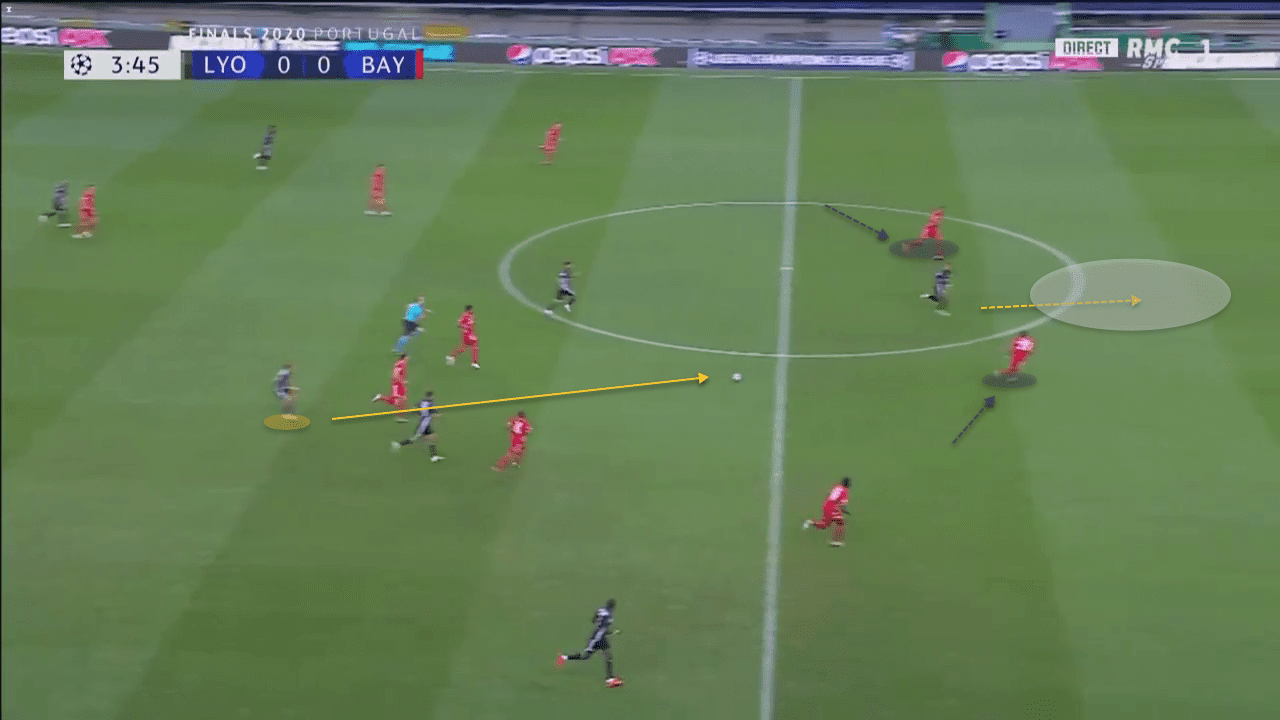
Battle of the half-spaces – Bayern
There is a very big chance the winner of this match will come down to which side is able to work most effectively in the half-spaces. Much of Bayern’s attacking focus comes in this area of the pitch. In this section, we will detail how Bayern could look to build attacks in this channel against PSG.
Thomas Müller’s involvement will be crucial for Bayern. With the occupation of space in the half-space and to provide width being maintained by the full-back and winger, depth being provided by the deep midfielders and centre backs, and height help by Lewandowski upfront, the German is given the freedom in Flick’s system to be a support player in numerous areas depending on where he identifies space to exploit. This has seen the best come out of Müller, who looks revitalised under the German manager’s tutelage.
His presence in this advanced midfield position will be the key in Bayern’s progression into the final third for a number of reasons. The German international is a constant threat with the ball at his feet – evident from his 21 league assists this campaign, a new Bundesliga record – but his biggest effect on this match could come from his movement off the ball.
Müller’s movement creates issues for every opponent due to his freedom to overload specific areas of the pitch. This, in turn, offers the opportunity for his teammates to exploit these spaces. We will focus on his movement in attacks using the wingers in this section.
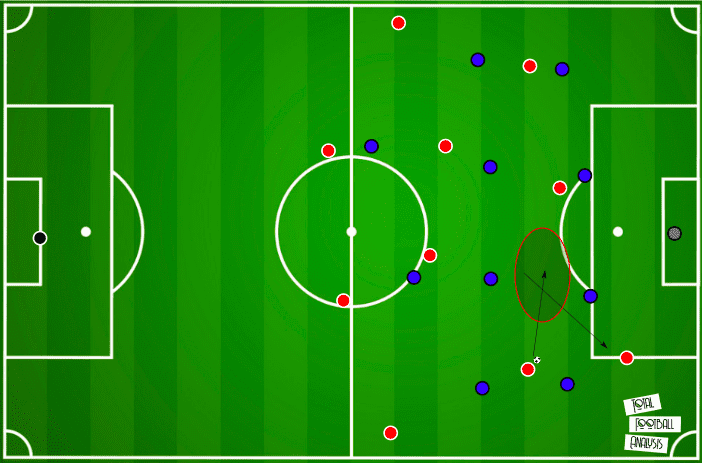
Müller’s flexibility allows him to move into wide positions to assist in the build-up in the half-spaces. Here he looks to combine with the likes of Serge Gnabry and Ivan Perisic and open up space in central areas for these wingers to move into, which is a staple of Bayern’s positional play. This often comes from his diagonal runs forward moving through the half-space into the channel. Rather than the purpose of this run being to offer a passing option for the player in possession, it is instead designed to pin the opponent’s centre back and stop them from attempting to cut off the winger’s movement into the centre of the pitch.
This principle can be seen in Bayern’s opening goal against Lyon. With Kimmich occupying the half-space position, Gnabry takes advantage of Lyon’s three-back system and bursts forward on the touchline to get beyond the defending wing-back and in space to receive a ball over the top.
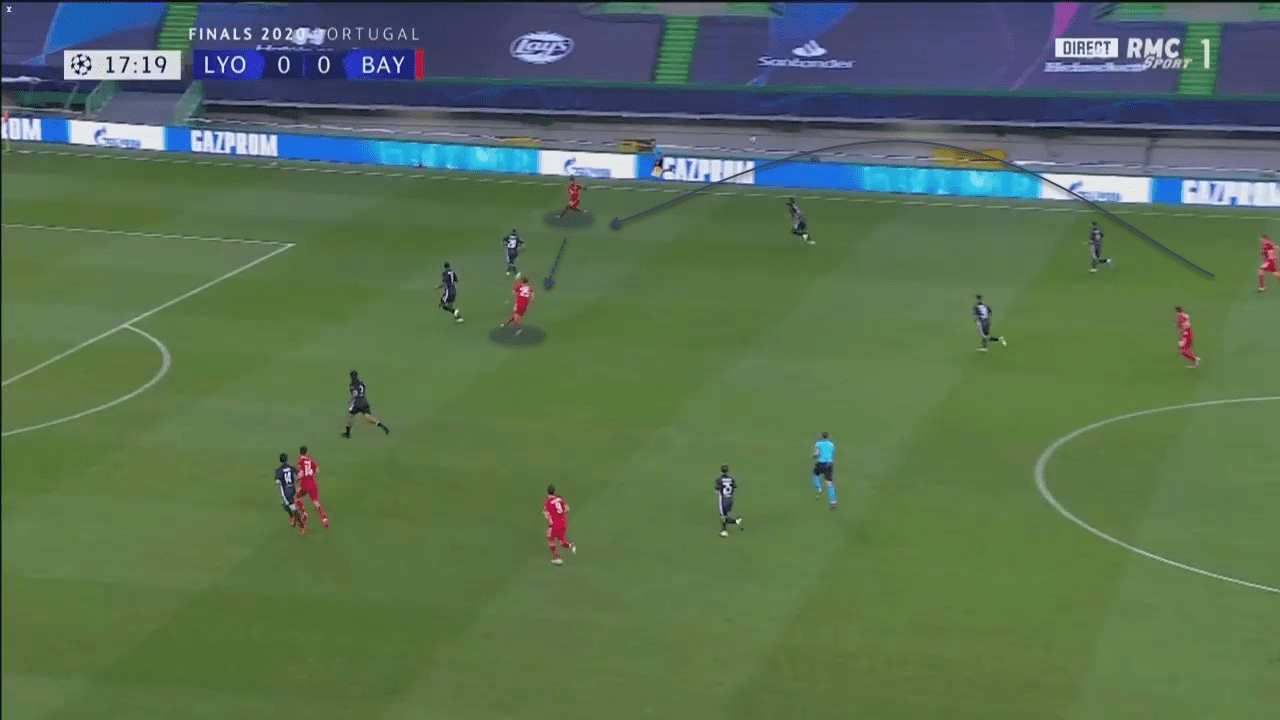
When Gnabry receives possession he immediately moves into the central channel, directing his run right at Müller. The midfielder acknowledges Gnabry’s intentions and immediately makes a run between the left and central centre-backs into the channel. This run freezes both players as they look to block off a pass into this space. However, Gnabry continues to take possession forward into the centre and is in open space to score the opener.
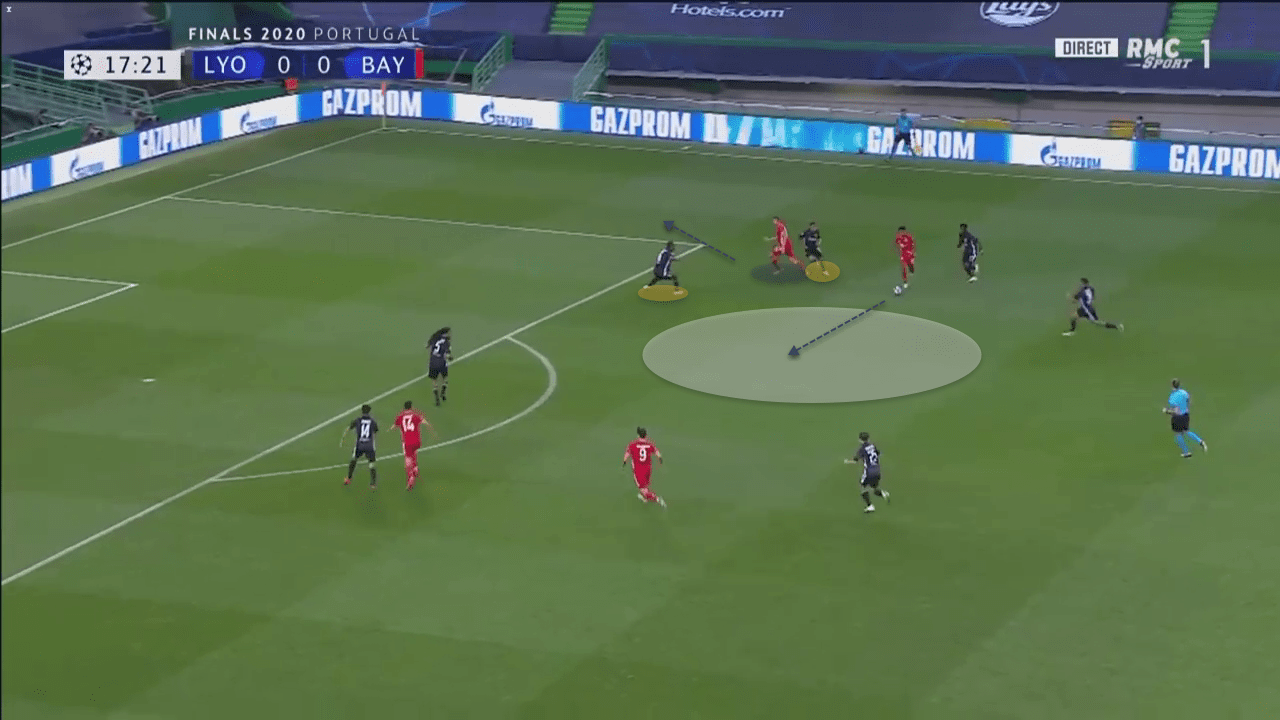
Winning the midfield
Müller’s movement in the centre of the pitch is also used to aid the deep-lying playmakers in their effects to access the final third. As the German drops into deeper positions, he looks to create overloads on the defending midfielders for the opponent. By positioning himself in the space behind these players, it keeps them from being able to push forward and press the likes of Thiago and Leon Goretzka when they are in possession. In Bayern’s match against Barcelona, we got to see what Thiago, in particular, is capable of when he is given time and space on the ball in these deeper central positions. Barcelona’s defensive line was picked apart by the Spaniard, most often using the half-space as his preferred passing channel.
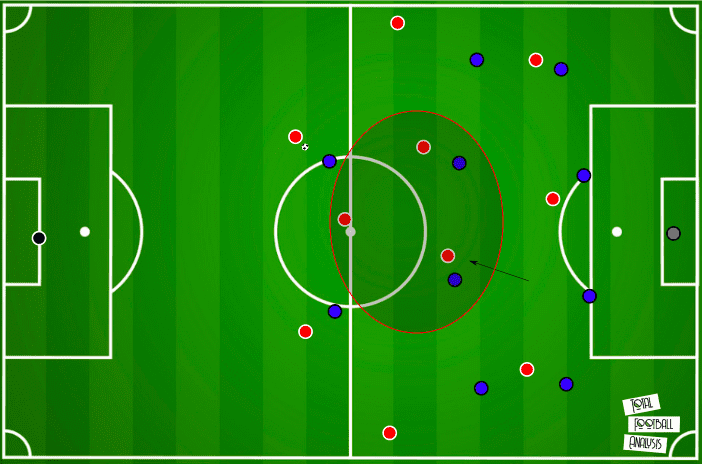
This midfield battle will be crucial in each side’s efforts on Sunday. As we discussed earlier, it is likely we will see Thiago dropping into space between Boateng and Alaba on Sunday, especially if PSG opt for a 4-4-2 defensive structure. With this being the case, Müller’s presence in deeper positions alongside Goretzka will be essential in ensuring Bayern are able to progress out of their first phase of build-up. His deep position would also give Bayern a 3v2 advantage in midfield against the 4-4-2 when possession is moved into midfield and Thiago rejoins this space. In the image above we see the midfield shape Bayern could look to utilise in these scenarios. Müller’s deeper presence would give Thiago more flexibility in being able to move in between the midfield and defensive line for Bayern.
To counteract this, PSG would be forced to drop one of the two strikers into a role closer to this midfield battle rather than using a wide player and risking becoming exposed in this area. The major benefit of this would be limiting the French side’s attacking outlets on the counter.
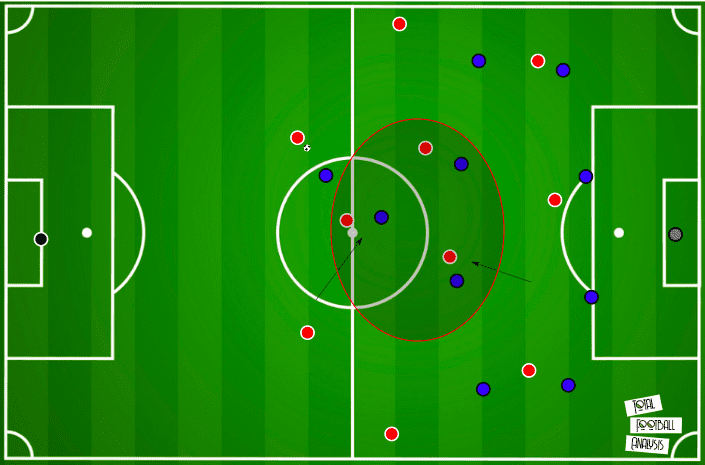
Restricting them to one player sitting on Bayern’s last line of defence rather than two would give the German champions a better chance to contain counters and break them down before they are able to fully develop.
Battle of the half-spaces – PSG
For PSG, their primary target areas will be similar, while going about it using a much different system. Tuchel’s 4-3-3 structure shifts into a 4-2-2-2 oftentimes in possession. This system is built primarily to get the best out of the French side’s personnel.
PSG’s greatest strength, much like Bayern, is their versatility with players able to play in multiple different positions. For PSG, in particular, this involves the use of a variety of different systems depending on how they are attempting to attack. Two players we will take an in-depth look at in this section are Neymar and Paredes.
These two players are typically working on the left side of PSG’s attack. Paredes has made a great impact in this tournament in Lisbon playing in a deep position here working alongside Marquinhos and pulling the opponent’s defensive blocks out of shape. The aim of this is to open space in behind the midfield line of the opposition for the likes of Neymar to receive possession with time to turn and use his dribbling ability to the fullest.
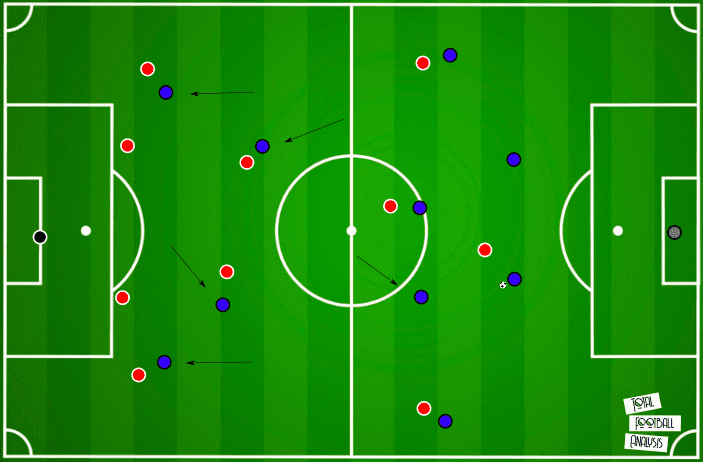
Herrera pushes forward in an advanced eight role on the right side which gives Neymar the freedom to move into this left position. Di María and Mbappé are responsible for keeping height for the side, working off the backs of either the centre backs or full-backs, depending on where possession is building up. Out wide, Kehrer and Bernat provide the width, but they are often only used for this purpose, while PSG use the preferred central channels to move possession through.
Paredes and Marquinhos work in tandem that gives two different looks to the side. However, as Bayern’s defensive system forms a 4-2-3-1 formation, it is likely we will see Marquinhos remain in the midfield most of the match in possession as he is not needed to drop deep to provide a numerical advantage against one forward. Here, the Brazilian acts as the central pivot, which gives Paredes the freedom to push wider left into the half-space and area that Bernat has vacated.
Using this space, the Argentine will aim to pull Bayern’s midfield out of position. With Marquinhos occupying Müller, Paredes will move off of the deeper midfielders in Thiago and Goretzka, where he will force them to make a decision when he gains possession: to move out of shape and press him to take away his time and space on the ball or hold their positions in order to restrict the space in behind for Neymar to exploit.
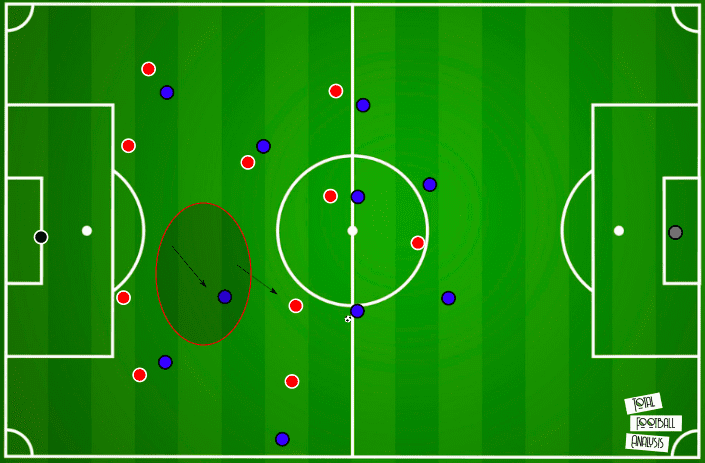
Against RB Leipzig, this tactic worked to great effect. Paredes’ movement often pulled Sabitzer out of the central channel. Neymar recognised this and consistently moved into this area to receive a pass with space to work in.
PSG are able to alter this structure depending on the opponents’ system while keeping the target channel the same. If Bayern presses high with two rather than one by pushing Müller forward, the French side will respond by dropping Marquinhos into the backline to create a three. This ensures they remain at a numerical advantage to ensure they are able to build up effectively. In turn, Paredes moves into a central pivot role, and Herrera and Neymar drop into deeper eight roles to offer support.
As mentioned, however, PSG’s target channel remains the same. The only difference is the outlet utilised. With Paredes holding a central role, Kimpembe is given the responsibility of unlocking this area of the pitch.
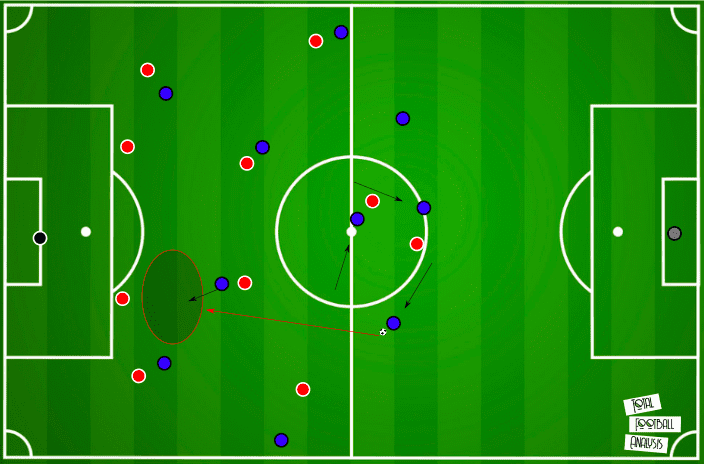
With a back three with Marquinhos, the focus will turn to attract the attention of Lewandowski and Müller to mark one of the three of Paredes, Marquinhos, or Thiago Silva. As soon as the opportunity presents itself, Kimpembe will spread wide into the left half-space and open himself up for a pass to move into space. The deep midfielder or winger of Bayern would then have to decide whether to press the centre back in this area. If they choose not to, Kimpembe will look to make a pass into the deep half-space for either Neymar or the forward-most attacking player on this side to try and get in behind or have a run at the defensive line.
Bayern’s dynamic full-backs
Against Barcelona, we were able to see just how effective Bayern can be attacking through their width. With Davies and Kimmich at full-back, both possess unique attacking characteristics that pose a constant threat to opponents. In this section, we will look at how Flick could use these areas to his advantage on Sunday.
This area will be highly contested and present a couple of different possibilities that could affect the end result of this match. For Bayern, the full-backs represent an outlet for their attacks. If PSG look to restrict the central and half-spaces by bringing more numbers inward around the likes of Thiago, Kimmich and Davies will be responsible for carrying possession into the final third. Davies showed against Barcelona his ability to beat players on the dribble. On Sunday, he will be working against Kehrer, a natural centre back. This gives Bayern the potential to look to exploit the German in 1v1 or 2v1 situations. One idea we could see is the initial build-up working down the right side before Kimmich or Thiago use their passing range to find a cross-field ball into Davies with space on the opposite side to look for these opportunities.
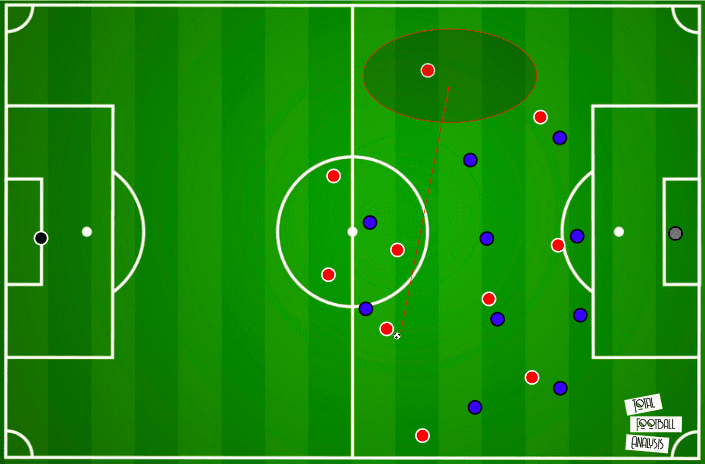
Moves like this could go on to open up different lanes to attack as well. As PSG work to shift over, Müller and Lewandowski can work off each other to make runs in behind the defensive line to offer options for the full-back now in possession. As well, Goretzka’s high attacking intelligence means his runs from deep are a threat that must be considered for an opposition.
Tuchel will be well aware of the threat this area represents for his side. To counter this, one tactic we could see is the use of Mbappé on the back shoulder of David Alaba. The Frenchmen has the speed to beat the Austrian on the counter, so with this in mind, Davies could be more hesitant in driving forward and leaving his defender exposed. This would, in turn, allow PSG’s deeper players, in whichever system they opt to use, to be more comfortable with keeping a favourable numerical situation in this position.
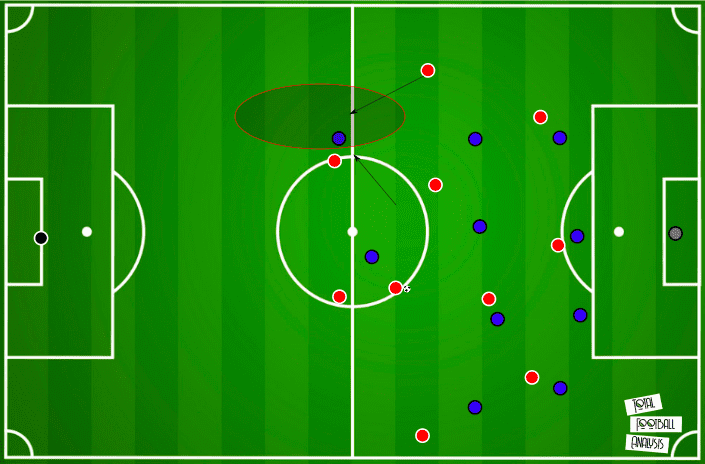
Once again Neymar would act as the fulcrum to the French side, offering a central outlet for his teammates in deeper positions. Mbappé would present an option too, but attempting to play it long into this channel first or second time consistently throughout the match would most likely end in Bayern regaining possession due to Manuel Neuer’s intelligence in coming out of his penalty area. This idea should rather be mainly considered as the countermeasure to restrict Davies, and the attacking focus should ideally be on finding Neymar in situations where the Brazilian can turn and dribble before then looking at options ahead which would include Mbappé’s movement in these areas.
Conclusion
This tie presents an extremely intriguing tactical battle. Both sides will look at their style and structure as ways that they can punish their opponents and come out winners on the evening. For Bayern, the focus will remain on the half-spaces. If they can successfully enter this area in the attacking third they have the creative players to punish PSG. On the other side, the French champions will be looking to do what their counterparts Lyon could not in exploiting Bayern’s high defensive line. With the two best players in the match upfront for PSG, they will fancy their chances in making the most out of the opportunities they get to catch their opponents on the break.






Comments